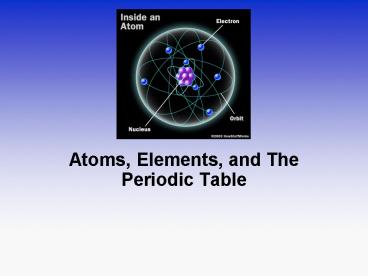Atoms, Elements, and The Periodic Table - PowerPoint PPT Presentation
1 / 14
Title:
Atoms, Elements, and The Periodic Table
Description:
Atoms Smallest particles of matter Have all the characteristics of the element The nucleus is the central part of the atom contains two types of subatomic particles ... – PowerPoint PPT presentation
Number of Views:181
Avg rating:3.0/5.0
Title: Atoms, Elements, and The Periodic Table
1
Atoms, Elements, and The Periodic Table
2
Atoms
- Smallest particles of matter
- Have all the characteristics of the element
- The nucleus is the central part of the atom
- contains two types of subatomic particles
- proton positively charged the number of
protons is the atomic number mass 1amu - neutron no electromagnetic charge mass 1 amu
- Electrons
- negatively charged particles
- negligible mass
- move around the nucleus at the speed of light.
- Atoms have the same number of protons and
electrons.
3
Elements
- Made of one type of atom.
- Pure substances
- Simplest form of matter
- Unique properties determined by the number of
neutrons, protons, and electrons. - There are 114 known elements
- 93 naturally occurring
- 21 synthetic
- Atomic weight of an element
- is the average of the atomic masses of all the
stable and radioactive isotopes of an element
4
- Isotope of an element
- Isotopes are atoms of an element
- same atomic number (same number of protons)
- Different number of neutrons
- Can be stable or unstable
- Unstable isotopes are radioactive and decay to
form atoms of other elements - examples
- U-238 decays to Pb-206 (half-life 4.5 Billion
years) - U-235 decays to Pb-208 (half-life 704 Million
years) - C-14 decays to N-14 (half-life 5730 years)
- any isotope which has an atomic number greater
than that for bismuth (Bi) is unstable
5
Periodic Table
- Shows all of the elements
- Elements are arranged by atomic number (number of
protons, from light to heavy.) - Rows are from left to right
- Columns
- grouped by similar characteristics
- known as Groups or Families
- Left side of table metals
- Right side of table nonmetals
- Middle metalloids
6
The Periodic Table
7
Group 1A Alkali Metals
- Very reactive
- All are metals except H
- Easily give up their one valence electron to
combine with nonmetals from group 7A Ex. NaCl
Cutting sodium metal
8
Opposites Attract
9
Valence Electrons
- Electrons are located in regions called energy
levels. - Each energy level contains a certain amount of
electrons - Valence electrons are the electrons in the outer
shell of an atom. - The amount of electrons in the outer layer
explains how atoms form compounds.
10
Group 2A Alkaline Earth Metals
- All are metals
- React with oxygen and water
- Have 2 valence electrons so they are not as
reactive as Alkali Metals - Ex. MgO, MgS
Magnesium
MgO
11
Transition Elements
- Most are hard and have high melting points
- These are all metals
- Give up valence electrons
- Have variable numbers of electrons
- Many form compounds of main ore minerals. Ex. Cu,
Fe, Mo, W
12
- Group 3A Metalloids, Includes Aluminum
- 4 valence electrons
- Group 4A aka Carbon Groups
- Includes metals and nonmetals.
- Elements have lower melting and boiling points.
- 5 valence electrons
- Group 5A Nitrogen Group have 6 valence electrons
- Group 6A Oxygen Family have 7 valence electrons
13
Group 7A The Halogens (salt makers) F, Cl, Br,
I, At
- Found in pairs, highly reactive
- Have 7 valence electrons
- React with alkali metals to form salts
14
Group 8A The Noble (Inert) GasesHe, Ne, Ar, Kr,
Xe, Rn
- Wont react because they have full electron
levels (8 valence electrons - All elements are gases































